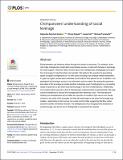Files in this item
Chimpanzees’ understanding of social leverage
Item metadata
| dc.contributor.author | Sánchez-Amaro, Alejandro | |
| dc.contributor.author | Duguid, Shona | |
| dc.contributor.author | Call, Josep | |
| dc.contributor.author | Tomasello , Michael | |
| dc.date.accessioned | 2018-12-13T17:30:05Z | |
| dc.date.available | 2018-12-13T17:30:05Z | |
| dc.date.issued | 2018-12-12 | |
| dc.identifier | 256600104 | |
| dc.identifier | a0498ba7-c33c-404c-916b-68a031903060 | |
| dc.identifier | 85058425617 | |
| dc.identifier | 000452898600039 | |
| dc.identifier.citation | Sánchez-Amaro , A , Duguid , S , Call , J & Tomasello , M 2018 , ' Chimpanzees’ understanding of social leverage ' , PLoS One , vol. 13 , no. 12 , e0207868 . https://doi.org/10.1371/journal.pone.0207868 | en |
| dc.identifier.issn | 1932-6203 | |
| dc.identifier.other | ORCID: /0000-0002-8597-8336/work/51700153 | |
| dc.identifier.uri | https://hdl.handle.net/10023/16682 | |
| dc.description.abstract | Social primates can influence others through the control of resources. For instance, dominant male chimpanzees might allow subordinates access to mate with females in exchange for social support. However, little is known about how chimpanzees strategically use a position of leverage to maximize their own benefits. We address this question by presenting dyads of captive chimpanzee (N = 6) with a task resulting in an unequal reward distribution. To gain the higher reward each individual should wait for their partner to act. In addition, one participant had leverage: access to an alternative secure reward. By varying the presence and value of the leverage we tested whether individuals used it strategically (e.g. by waiting longer for partners to act when they had leverage in the form of alternatives). Additionally, non-social controls served to show if chimpanzees understood the social dilemma. We measured the likelihood to choose the leverage and their latencies to act. The final decision made by the chimpanzees did not differ as a function of condition (test versus non-social control) or the value of the leverage, but they did wait longer to act when the leverage was smaller—particularly in test (versus non-social control) trials suggesting that they understood the conflict of interest involved. The chimpanzees thus recognized the existence of social leverage, but did not use it strategically to maximize their rewards. | |
| dc.format.extent | 1243872 | |
| dc.language.iso | eng | |
| dc.relation.ispartof | PLoS One | en |
| dc.subject | BF Psychology | en |
| dc.subject | QH301 Biology | en |
| dc.subject | DAS | en |
| dc.subject.lcc | BF | en |
| dc.subject.lcc | QH301 | en |
| dc.title | Chimpanzees’ understanding of social leverage | en |
| dc.type | Journal article | en |
| dc.contributor.institution | University of St Andrews. Centre for Social Learning & Cognitive Evolution | en |
| dc.contributor.institution | University of St Andrews. School of Psychology and Neuroscience | en |
| dc.identifier.doi | https://doi.org/10.1371/journal.pone.0207868 | |
| dc.description.status | Peer reviewed | en |
This item appears in the following Collection(s)
Items in the St Andrews Research Repository are protected by copyright, with all rights reserved, unless otherwise indicated.

